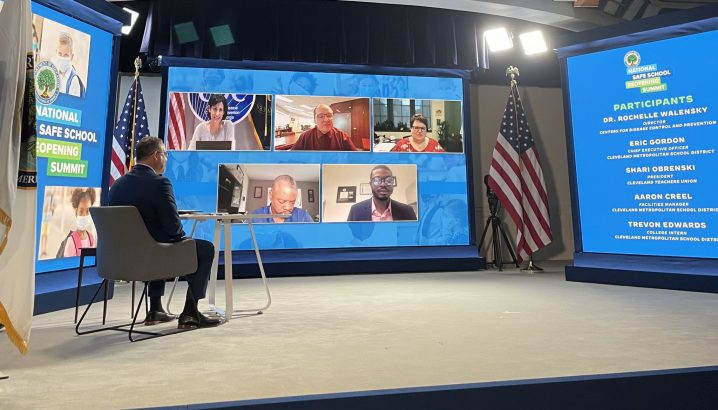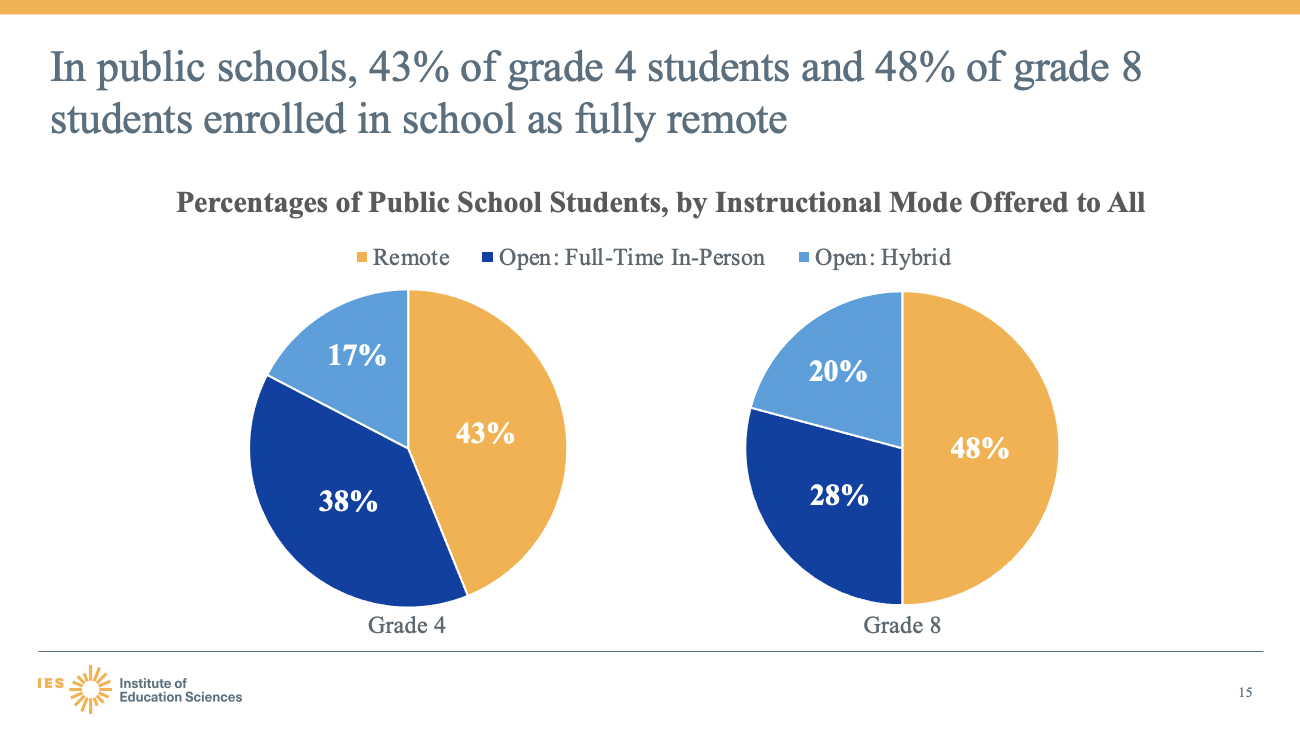Cardona Summit Shines Light on Districts With Successful Reopening Stories and ‘Real-World Evidence’ of Following CDC Guidelines

U.S. Education Secretary Miguel Cardona will travel to local communities over the next few weeks in a continued push to get more schools to reopen before the Biden Administration’s self-imposed 100-day deadline.
“My job, I can do it better if I’m listening to what is happening in the field,” Cardona told viewers during a summit designed to highlight progress districts have made bringing students back to the classroom and to address pandemic-related learning loss.
As part of those efforts, the department announced it will team up with state education chiefs and governors to support states’ summer learning efforts. Under the new American Rescue Plan, states have to set aside 1 percent of the $122 billion specifically for summer learning.
District leaders at the online summit shared examples of summer camps and academies they’re planning to finance with the relief funds.
“Learning happens as much outside the four walls of the classroom as much as inside,” said Paula Shannon, deputy superintendent of the Tulsa Public Schools. She added the district will partner with the YMCA and parks and recreation programs to serve students over the summer.
The Cajon Valley Unified School District, near San Diego, is planning Camp Cajon to focus on grade-level standards but also enhance its growing push to connect the curriculum to future career pathways for students.
Cardona stressed that he wants districts to be creative about engaging students this summer. “I’m not talking about skill and drill, none of that,” he said.

Wednesday’s summit — a virtual event involving department officials, district leaders and students — followed Friday’s updated guidance from the Centers for Disease Control and Prevention, which reduced allowable social distancing in classrooms from 6 to 3 feet. The goal of the summit, Cardona told state chiefs Tuesday, is to take “control of the narrative by emphasizing “that our educators are doing amazing work” and to learn from others facing similar challenges around the country.
One of those challenges may be maintaining support from teachers unions as more students return to school.
In a Tuesday letter to Cardona and the CDC, American Federation of Teachers President Randi Weingarten expressed concern over the guidance change and raised a series of questions about how it would affect daily logistics, from working with students in small reading groups and managing bus routes.
“Weakening one layer of layered mitigation demands that the other layers must be strengthened,” she wrote. She’ll have an opportunity to ask Cardona these questions directly on Thursday when he participates in a conversation with her at a union conference.
The Seattle Public Schools is one of the districts planning an initial return of young children next week. The state hasn’t adopted the 3-feet guidance yet, but if it does, the district and union would have to renegotiate the terms of reopening, said Julie Popper, a spokeswoman for the Washington Education Association.
“A lot of unions have been at the bargaining table continuously since last year because the science keeps evolving,” Popper said, adding that unlike normal contract talks, there’s been no precedent for how to make such agreements. “This is a road we had to make by walking it.”
At the summit, Eric Gordon, CEO of the Cleveland Metropolitan School District, stressed how maintaining a close working relationship with the Cleveland Teachers Union helped solve problems related to reopening and minimize disruption for students adhering to a hybrid schedule.
“The dirty little secret is, as hard as closing was, opening is harder,” Gordon said, adding that in some cases two teachers work together to share in-person and hybrid groups to minimize disruption.
But some speakers focused on the quick adjustments educators had to make when coronavirus cases spiked. United Federation of Teachers President Michael Mulgrew said New York City was “hit so hard, so quickly that as we started to plan, we were facing the reality that more and more of our school-based staff was dying.” The district and the union, he said, had to “face the anxiety and the fear.”

CDC Director Dr. Rochelle Walensky, who co-hosted two of the panels with Cardona, said schools seeking to reopen got a boost with research showing 3 feet of distance is sufficient as long as mask wearing is enforced.
“We have real-world evidence to show that this is truly possible,” said CDC Director Dr. Rochelle Walensky. “We believe these updated recommendations are another important step in getting our students back to in person learning.”
Disparities in in-person learning
But new Institute for Education Sciences data shows that the nation still has a long way to go. A School Survey released Wednesday shows almost half of eighth graders and more than 40 percent of fourth graders were still in fully remote classrooms in January. While the majority of schools — 76 percent — have offered some in-person instruction this year, there are wide differences in students’ participation by race and region.
Twenty-seven percent of white fourth graders were still in fully remote classes in January, but the rates were far higher for Black, Hispanic and Asian students, ranging from 58 percent to 68 percent. Over a third of students in the South and Midwest were enrolled in full-time in-person learning, but less than a quarter were attending in person in the West and Northeast.
The survey, to be administered four more times before the end of the school year, is the department’s response to President Joe Biden’s executive order to collect data on where and how students are participating in school. The survey sample includes 3,500 schools each in fourth and eighth grade, but the results can be generalized to include students in other elementary and middle grades, said Peggy Carr, the associate commissioner of the assessment division for the National Center for Education Statistics.

The results show that in January, low-income students, English learners and students with disabilities did not attend school in person at significantly higher rates than other students. And one third of fully remote schools provided two hours or less of live instruction every day in both fourth and eighth grade.
“We knew it was going to be low, but not quite that low,” Carr said.
Cardona emphasized the availability of new resources to accelerate the return to school. Timed with the summit, President Joe Biden announced that $81 billion in relief funds is on its way to states to support reopening.
“With that money we can address those inequities,” Cardona said.
‘Our counselors, our friends’
Stanford University scholar and California State Board of Education President Linda Darling-Hammond led a discussion on how districts are addressing some of those inequities and supporting students’ academic, social and emotional needs. She asked the speakers about practices their districts plan to continue using after the pandemic.
In Tulsa, that includes wellness teams at each school to focus on students’ technology, health, attendance and other needs.
“We use that data to truly mobilize resources and supports for our students, our families and our staff members,” said Ebony Johnson, the district’s senior director of student engagement.
Similarly, the Cajon Valley district added an advisory program to strengthen relationships with students.
“They are not only our teachers,” said Anisha Ward, an eighth grader at Bostonia Language Academy, a dual language school in the district “Now they are our counselors, our friends.”
While several speakers stressed the importance of family engagement over the past year, some observers noted the absence of family representatives at the summit. “The education community needs to get out of this mindset that only people who do education professionally have anything to contribute,” said Eileen Chollet, a Fairfax County, Virginia, mother who filed a complaint with the Virginia Department of Education over a lack of in-person instruction for her special needs daughter. “It’s not that we feel entitled to get our way. We are taxpayers and we elect the school board.”
At the summit, administrators said the pandemic taught them new ways to communicate with parents, such as using Facebook and other social media. Karen Minshew, assistant superintendent in Cajon Valley, said the district has held roughly 100 virtual town halls in the past year.
“We have never engaged this much with our families and our communities,” she said, adding that the district focuses on staff and student well-being with frequent surveys. “In order to have happy engaged kids — pre- or post-pandemic — we need a culture of happy engaged adults.”
Get stories like these delivered straight to your inbox. Sign up for The 74 Newsletter

;)
